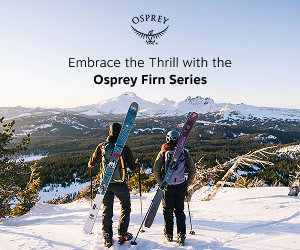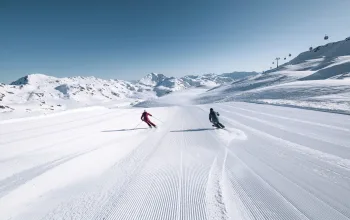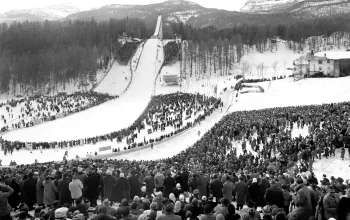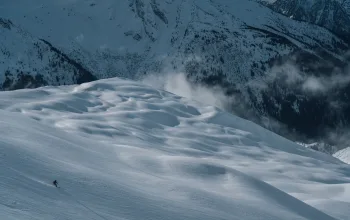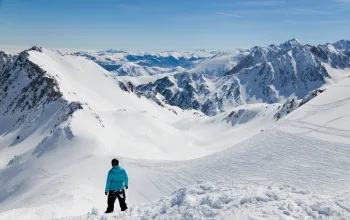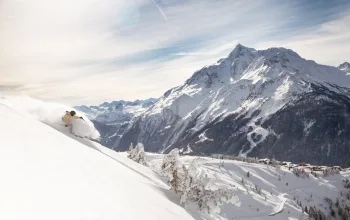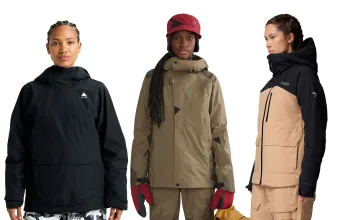Sit down for a feast in Georgia, and you’ll notice three things: firstly, Georgian wine is amazing. They have a rich winemaking culture which stretches back 8,000 years, and archaeologists believe they may have invented the stuff. Secondly, the food is incredible, mixing Mediterranean and middle-eastern flavours to create a cuisine that’s unlike anything else. And third, it just keeps coming. Plates of badrijani, or stuffed aubergines; earthenware pots filled with lobio, a hearty bean stew, and shkmeruli, roasted chicken thighs in garlic sauce—all arrive at the table in waves.
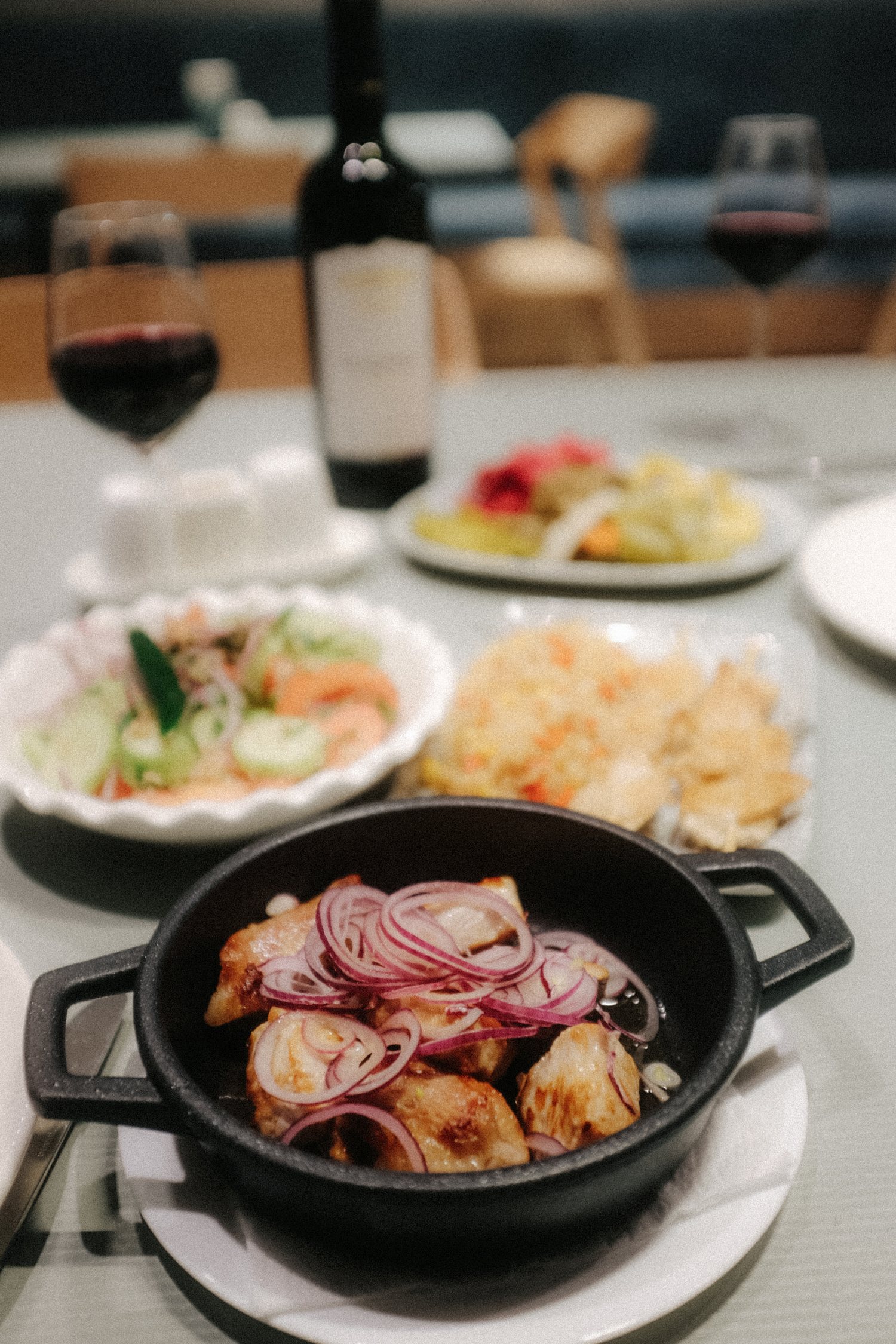
These are swiftly followed by piles of shashlik, kebabs served with raw onions; bowls full of khinkali, steamed gyoza-like dumplings, and platters of piping-hot khachapuri, a pizza-like cheese bread with a poached egg baked in. The dishes seem to magically replenish themselves, like a welcome banquet at Hogwarts.
I got a taste of all of these—and Georgians’ legendary reputation for hospitality—on my first night in Mestia. We were sitting at long tables in the Hotel Gistola, surrounded by a mix of nationalities: Georgian, French, Swiss, Canadian, Spanish, Italian—I could hear five languages being spoken at my table alone. As the plates continued to arrive, space grew scarce. But the waiters didn’t stop, they simply balanced new dishes precariously on top of the unfinished food.
“We’d just watched the world’s best ride a pristine powder face”
In fairness, there was a lot to celebrate. We had just watched—or, in the case of some of my tablemates, participated in—the first ever Freeride World Tour (FWT) event in Georgia. Forty-nine of the world’s best backcountry skiers and snowboarders had spent the day picking lines down a pristine, powder-laden face, segmented by steep couloirs and consequential cliffs. The event had been watched live by hundreds on the hill, and broadcast to hundreds of thousands online. And the whole thing had gone off without a serious hitch.
“We were very happy with the way it went,” said Nicolas Hale-Woods, the tour’s CEO. Running an event like this is a huge feat of teamwork, he explained. There were 60 people from the FWT, including alpine guides, photographers, and the two doctors sitting next to me at the feast. (“We usually have one travelling with the tour, but for somewhere like this, they wanted two,” they said.) A further 40 people—plus a helicopter, snow cats, and snowmobiles—were provided by the Mountain Trails Agency (MTA), the Georgian government body which runs the country’s ski resorts. And then there were the dozens of local drivers who ferried people to and from Tetnuldi, the resort outside Mestia where the contest took place. “In a country where there were many question marks about how it would all work, all the boxes were ticked,” said Hale-Woods. The proof of the pudding was just how much the riders were buzzing. “Their stoke is what drives us,” he said, “and they were super happy about the venue and the snow conditions.” Judging by the volume of their singing, some of them were getting happier still as the evening wore on.
“Honestly, I had no idea what to expect,” Erin Suavé, the 34-year-old Canadian who finished second in the women’s snowboarding, told me the following day, once the party was over and the hangovers had cleared. “I didn’t really have any preconceptions about Georgia, but it’s phenomenal here—the mountains are amazing, and the lifts are surprisingly new and fancy.” This was Suavé’s first winter on tour, she explained. Incredibly, given she went on to win the overall title, she’d still been working at her local ski school the previous winter. But it wasn’t just rookies like her who were impressed—even the experienced pros visiting Georgia for the first time had been blown away. “The mountains here are just so huge and beautiful,” said Norwegian Peak Performance athlete Hedwig Wessel, a two-time Olympian who, like Suavé, went on to win the 2024 FWT title. “Particularly Tetnuldi, that massive mountain above the resort. It’s insane.” Victor de le Rue, the freeriding legend who won the men’s snowboarding category, told me he was already thinking about a return trip with a film crew. “You can just feel there’s so much potential here,” he said.
This was high praise indeed, and music to the ears of the local organisers. “It’s the first time I have the feeling that Georgia is really on the map as a global ski destination,” the MTA’s Director Irakli Burchuladze told me, beaming with pride. The conversation about staging an FWT contest in Mestia had started two years ago, he explained. But it marked the culmination of a much longer journey.

Against the odds
Geographically, Georgia has all the attributes you’d want for a world-class winter-sports destination. Sitting at the intersection between Europe and Asia, it’s bordered to the west by the Black Sea—the source of tempestuous, moisture-laden storms—and to the north by the mighty Caucasus mountains, where those same storms dump their heavy loads as snow over 5,000m peaks—higher than anything in the Alps. Add in the aforementioned incredible food and wine and you have a very enticing proposition for adventurous skiers.
Unfortunately, Georgia’s geography has also been its curse. Sandwiched between squabbling neighbours, it endured occupation by the Persian and Ottoman empires, before finally being annexed by the Russians in 1801. For the best part of 200 years, the country was treated as an imperial backwater—even while Stalin, himself a native Georgian, sat in the Kremlin. And then in 2008, when an independent, post-Soviet Georgia started turning towards Europe, Putin sent in his tanks—his invasion foreshadowing that of Eastern Ukraine, six years later.
In the Laila café, a hipster-ish hangout in the middle of Mestia, the staff wear hoodies saying “20 percent of my country is occupied by Russia!”—it’s a state of affairs that leaves many Georgians, particularly younger Georgians, furious to this day. Yet despite the political odds being stacked against it, Georgia’s tourist industry has boomed in the past 20 years. The differences between when I visited—as a student in 2005—and today were starkly visible as soon as I landed in Tbilisi, the capital. The town of Mestia, meanwhile, almost serves as an advert for the transformative power of winter sports tourism.

As we drove northwest from Tbilisi towards the mountains, the roads became steadily worse, and the roadside villages steadily more rural. By the time we reached the Svaneti region, my transfer driver was regularly dodging fallen rocks, beeping sheep off the road, and struggling with a surface that was practically one huge pothole. But arriving into Mestia was like fast-forwarding 20 years into the future. New looking hotels, ski shops, and busy restaurants suddenly sprung up between the traditional homesteads. There were many more cars on the road, and brightly-attired skiers were everywhere.
Mestia’s ski-fuelled boom is no accident, according to Irakli Burchuladze of the MTA. “Historically, it was a destination for mountaineering and trekking, but the central government was convinced to invest so it could become not just a summer destination, but winter also.” The first lifts were installed at Hatsvali, on the edge of town, in 2007, he said. “Then in 2014, they opened the lifts at Tetnuldi.” And what was previously a trickle of international visitors became a steady stream.

In the days following the FWT event, we met ski tourers from Austria, Italy, Hungary and Poland on the skin tracks around Mestia—none of whom had any connection with the tour. One morning I shared a chairlift at Tetnuldi with a mountain guide from Verbier who told me he brought his clients here every year. And I even met some old friends, purely by chance. James Stentiford and Neil McNair, two British guides who run backcountry snowboard trips, explained that they’d practically become regulars in Mestia, having led groups of UK shredders here for the past four winters. The local ski touring industry got a huge boost in 2021, when the Georgia Mountain Guides Association (GMGA) was admitted to the International Federation of Mountain Guides Associations (IFMGA). This means Georgian guiding qualifications are now recognised as equivalent to European ones—and crucially, local guides can charge more for their services. This recognition was the result of a decade of work by Ilia Berulava, Georgia’s first-ever IFMGA qualified guide, who set up the GMGA. “There are now 35 fully-qualified mountain guides here,” he said proudly, “and we have more aspirant guides joining our training program every year.”
Increasingly, however, it’s not just ski tourers who come to Mestia. In the on-mountain viewing zone for the FWT, I met Ruth McTigue and Jason McGloin, two friends from Galway on the west coast of Ireland. “This is actually our second time here,” McTigue told me. “We love the resort, the snow is amazing, and it’s so much cheaper than Europe.” McGloin agreed. “Sure it’s a bit more adventurous, but I’d say lots more people will be wanting to come here once word gets out about how great it is.”

A slice of paradise
As the pilot gunned the throttle, the helicopter rose above the treeline, and the valley floor unspooled beneath us. From here, you could see everything. The lifts of Hatsvali below, the slopes of Tetnuldi behind, and away to the right, the modern hotels of Mestia poking out between the town’s traditional Svan towers [see below]. Photographer Dan Medhurst and I had spent several days touring—scaring ourselves in the steep couloirs off the top lift at Tetnuldi, as well as enjoying the more mellow slopes around Ushguli, a picturesque village nearby. Today, however, we’d managed to secure the last two places on an Airbus B3 Ecureuil, alongside Swedish FWT athlete Kristofer Turdell, and his friend and photographer Elias Lundh. We were going heli-skiing.
Seeing Mestia from the air not only put the whole of the MTA’s development project into perspective, it gave us a spectacular view of why the Georgian government had chosen this valley to invest in in the first place. The town is surrounded by a ring of glaciated peaks roughly the same height as Mont Blanc, but two in particular stand out. Ushba, a twin-peaked mountain of 4,710m, and the 4,858m-high Tetnuldi, whose summit towers over the ski lifts on its foothills.

The mountains sit opposite each other, and Guro Alapishvili, the Tbilisi-based trekking guide who’d served as our driver, fixer, and chief party instigator for the week, told us that locals like to think of them as lovers. “The story goes that Tetnuldi’s parents forbid her to marry Ushba, because he was from a poor family,” he said. “But God felt sorry for them so he turned them into mountains so they could look at each other for all eternity.” According to the legend, the glaciers cascading down Tetnuldi’s flanks were the remains of her wedding dress.
While these star-crossed mountains looked even more beautiful from up high, we quickly turned our backs on them. “We’re flying to the Laila range,” explained our heli-skiing guide, Nick Phaliani. “It’s a little lower, but it’s closer to the Black Sea, so it always gets dumped on first.” Although it hadn’t snowed for several days before we arrived in Mestia, we had enjoyed pretty amazing snow all week. The north facing slopes, as a rule, had stayed cold and remarkably fresh. But the snow that Phaliani found us that morning, on the glaciers of Mount Laila, knocked everything else into a cocked hat.

Watching Turdell pick out lines through this perfect powder, double dropping cliffs as easily as riding a blue run, was pure poetry in motion. But Phaliani was no slouch on a pair of skis either. A homegrown Mestia success story, he was one of the first mountain guides to train with Ilia Berulava’s GMGA, he said, and was now training new guides in turn. His easy manner, clear instructions, and effortlessly smooth skiing inspired confidence. The only risk we seemed to face was that our stoke levels might hit dangerous new highs.
Every time we took off, we could see yet more endless, empty terrain. On the lower slopes there were well-spaced birch forests, perfect for tree skiing. Higher up, there were dramatic seracs. “It kind of looks like Japan, with Chamonix added on top,” said Turdell, shaking his head in awe. Having won the tour previously, he said that he’d thought about skipping it this year. “But then I heard they were coming to Georgia and I thought ‘I can’t miss that.’ I think I made the right decision,” he grinned.
“The mountains look like Japan, but with Chamonix added on top”
Back in town that evening, our group gathered to celebrate in the approved Georgian manner, with a feast at the Lushnu Qor, Guro Alapishvili’s restaurant of choice. We were joined by Berulava from the GMGA and Niklas Lundgren, a friend of Turdell’s who works for the FWT’s main sponsor, Peak Performance. Alapishvili, a source of non-stop stories, was once again holding court. At one point as the toasts were going round (“To an incredible day!” “To amazing skiing!” “To Georgia and the Georgians!”) he hushed us. “You know guys, there is a legend about how the Georgians got their land. When God made the Earth, he kept his favourite bit for himself. But then some people broke in and started getting drunk and rowdy. God said: ‘Hey, who are you and why are you partying in my piece of paradise?’ And they said: ‘We are Georgians! But we are not partying, we are celebrating you.’ God laughed and said: ‘OK, I like you guys. You can stay. If you are Georgians, we will call this piece of paradise Georgia.”

Svan Towers & Shoot Outs
One thing you can’t miss in Mestia—or indeed anywhere you travel in the Svaneti region—are the tall, castle-like towers dotted around the landscape. Many of these date from the 13th and 14th centuries, according to Guro Alapishvili, our guide. While all Georgians are fiercely independent, the Svans have a reputation for being particularly rebellious, he said. “As well as being famous as hunters and marksmen.”
Although they tried, the feudal lords who ruled Georgia in medieval times rarely managed to tame Svaneti, Alapishvili explained. So instead of each settlement having a single castle where power was concentrated, individual families would build their own individual defensive towers. Local families would occasionally band together to repel invaders. But more frequently, the towers would be used to attack their neighbours, when all-too-common blood feuds broke out.
Powerful Svan families resisted outside control well into the 21st century. Alapishvili told us the incredible true story of the Aprasidze family (which subsequently ended up in the European Court of Human Rights). In the early 2000s, they controlled one of the main roads towards Mestia, extracting “taxes” from people passing through. Having tried and failed to arrest them for “multiple murders, numerous episodes of armed robbery, kidnapping, extortion and so on,” the Georgian government eventually sent in special forces in March 2004. The head of the family and one of his three sons were killed in the shootout, while the others were arrested—but not before they’d managed to get to their tower, and shoot down a military helicopter with a rocket launcher!

Snow How
Our Trip
Tristan and Dan’s trip was organised and supported by the Freeride World Tour and Georgia’s Mountain Trails Agency.
Getting there
The best way to get to Mestia is to fly from the UK to Istanbul, and then onto Kutaisi, a 4h30m drive away. Pegasus Airlines operates Istanbul-Kutaisi flights three times a week. Flying Istanbul to Tbilisi, like we did with Pegasus, is also an option, but it adds a further four hours to the journey.
Where to stay
We stayed at the modern, comfortable 4-star Hotel Gistola. If you’re looking for something a little cheaper, the Hotel Old House Mestia is a great option in the old town. It’s been owned by the same family for at least 1,000 years. Both can be found on booking.com.
Guides and getting around
The best way to get around is to book a GMGA-accredited local guide like Guro Alapishvili, who can also arrange airport transfers and transport around town. His WhatsApp is +995 599 655 334. Details for him and his colleagues, including IFMGA alpine guides like Nick Phaliani and Ilia Beruleva, can be found on the GMGA website.

Heli-skiing
We went heli-skiing with Flory Kern. Originally from Austria, he set up the first heli-skiing operation in Svaneti 14 years ago. He works with local guides, but his helicopters, pilots and mechanics come from Italy.




